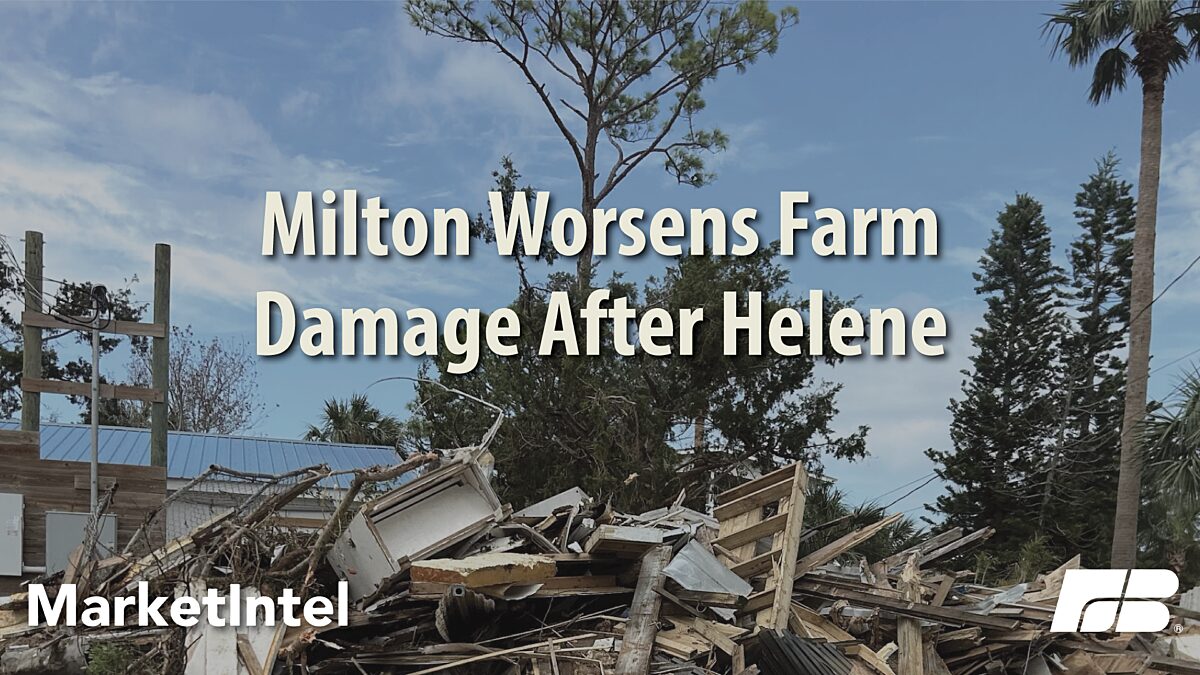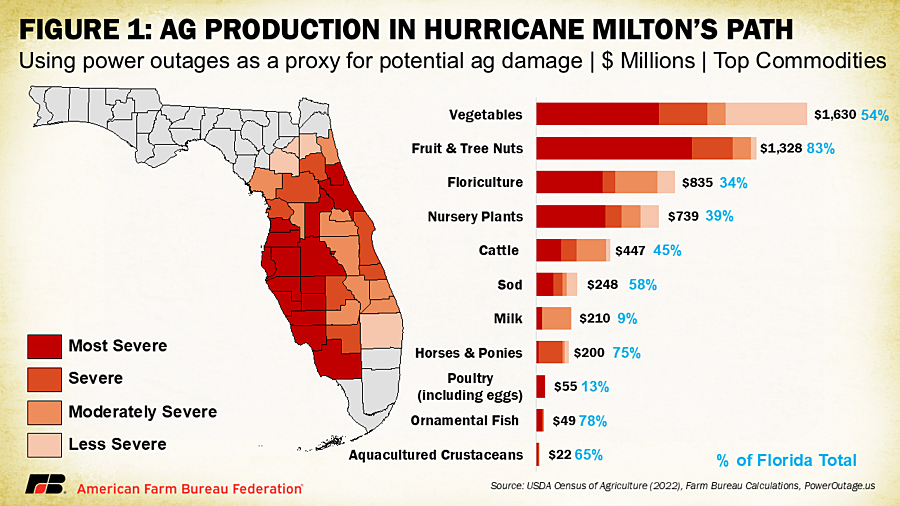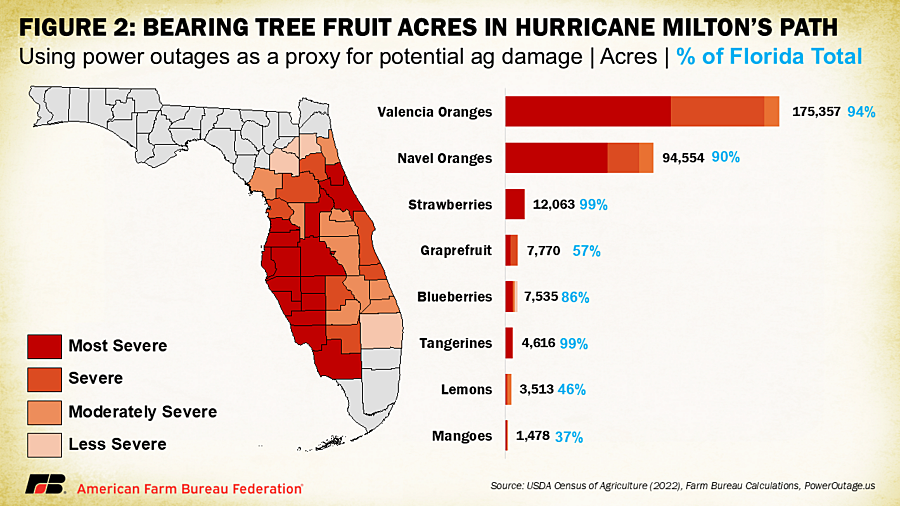Double Blow to Florida Farms: Hurricane Milton Worsens Damage After Helene

Daniel Munch
Economist
Following Hurricane Helene's devastating strike in Florida's Big Bend, Hurricane Milton made landfall two weeks later, further exacerbating the state's challenges. Milton, the second Category 5 hurricane of the season, came ashore as a Category 3 near Siesta Key, Florida, and pummeled Central Florida with catastrophic rain, storm surge, and 100 mph wind gusts. The storm resulted in widespread flooding, tornadoes, and power outages, causing severe damage across Florida’s agricultural regions. Multiple lives were lost, and many communities now face the daunting task of recovery.
Methodology
This report assesses the potential agricultural damage from Hurricane Milton using data from the 2022 U.S. Census of Agriculture, combined with power outage data from Oct.10. Power outages are used as a proxy to gauge the most severely impacted areas, with counties categorized as most severe, severe, moderately severe or less severe based on the percentage of power loss. While this is not a perfect measure of agricultural damage, it provides a reasonable indicator given the strong correlation between power outages, flooding and wind damage with infrastructure damage and crop losses. Overall, the counties affected by Hurricane Milton produce more than $7.4 billion in crops and livestock annually meaning that even a 20% loss would amount to nearly $1.5 billion in agricultural damages, excluding any losses from infrastructure or timber.
Vegetables: Leading Agricultural Sector in Impacted Counties Experiences Losses
Vegetable production is the largest agricultural sector in the counties impacted by Hurricane Milton, with a total value exceeding $1.6 billion reflecting 54% of Florida’s total vegetable production.
Florida grows nearly $750 million in tomatoes annually and accounts for over 70% of the nation’s fresh-market tomato production. Two counties—Manatee and Hillsborough—account for close to 40% of the state’s tomato production, and both were directly in Milton’s path. The storm’s high winds and torrential rain caused flooding in fields and extensive damage to greenhouses and protective structures. Tomato plants that were in earlier stages of growth were particularly vulnerable, and growers face the challenge of replanting crops just as they were preparing for harvest in the coming months (November and December are both peak harvest months for tomatoes in Florida).
Other vegetables in the region also suffered damage. Florida is a major producer of sweet corn ($252 million annually, representing over a quarter of U.S. production by value), bell peppers ($187 million, 31% of the U.S. total), snap beans ($138 million, nearly 40% of the U.S. total), and cucumbers ($86 million, 30% of the U.S. total). These crops are particularly vulnerable to waterlogging and disease outbreaks due to the saturated soil left in the storm's wake. While widespread damage is expected, the exact toll on yields and quality will not be fully known until more comprehensive assessments can be completed.
Adding to the challenge is the impact of federal food safety regulations. Under Section 402(a) of the Federal Food, Drug, and Cosmetic Act, any edible portion of a crop exposed to floodwaters is considered adulterated, with “no practical method of reconditioning the edible portion” to ensure it is safe for human consumption. This means that many of the vegetable crops affected by Hurricane Milton—such as tomatoes, string beans, and cucumbers—are likely unsellable if they were exposed to floodwaters.
Damage to Florida’s Citrus Industry
The fruit and tree nut sector, which generates over $1.3 billion in agricultural sales in the impacted counties, was the second-highest agricultural production category in the path of Hurricane Milton. In particular, the state’s iconic citrus industry took a direct hit. Counties affected by the storm account for 83% of Florida’s total fruit and tree nut production which includes 94% of Florida’s Valencia orange acreage and 90% of Florida’s navel orange crop acreage.
Before 2014, Florida produced over 70% of the nation’s oranges, but the industry has been steadily declining since 2005 due to citrus greening disease, hurricanes, and labor and land-use challenges. Hurricane Milton exacerbated these issues, with winds knocking significant amounts of unripe fruit to the ground, reducing the anticipated harvest.
The storm’s heavy rains also flooded many groves, leading to waterlogged soil and increased risk of root rot. Infrastructure critical to citrus production—such as irrigation systems, packing houses, and transportation routes—was heavily damaged, disrupting supply chains and increasing operational costs. Additionally, the increased moisture levels create conditions ripe for the spread of citrus canker and other fungal diseases, further reducing the future quality and marketability of any remaining fruit.
Strawberry Growers Hit at a Critical Time
Florida is the second-largest producer of strawberries in the U.S., generating over $430 million annually across more than 12,000 acres. Approximately 99% of Florida’s strawberry acreage was right in the path of Hurricane Milton. Many strawberry operations had just planted or were about to plant strawberry transplants when the storm hit. Typically planted between September and November, strawberries are harvested starting in December and continue to produce fruit through the spring.
The storm’s high winds ripped plastic mulch coverings, which are important for weed control, moisture retention, and disease prevention. Without these coverings, strawberry plants will be vulnerable to disease, and growers will face additional costs to repair or replace damaged infrastructure. Additionally, facilities that store strawberry transplants at the ideal temperature (32-35°F) lost power, jeopardizing thousands of plants before they could be replanted. For farmers who had already planted, flooding necessitates replanting and may delay future harvests.
Floriculture, Nursery Crops, and Sod: Infrastructure and Crop Damage
In the affected region, over $830 million in floriculture and $730 million in nursery crops were at risk. Floriculture and nursery crops are particularly vulnerable to high winds and flooding. There are reports of damaged and destroyed greenhouses, shade houses, and other protective structures resulting in plant and infrastructure losses. Without power, irrigation and climate control systems fail, causing potential further damage to sensitive plants.
The sod industry, valued at $248 million in the affected counties, is expected to also face challenges due to Hurricane Milton’s flooding. While the full extent of the damage is still unclear, sod fields are highly vulnerable to waterlogging, and early reports suggest widespread saturation of the soil, which could lead to root suffocation and loss of crop quality.
Sugarcane and Livestock: Widespread Challenges
Florida’s sugarcane industry, concentrated in the southern part of the state, was also at risk. Although detailed data on sugarcane production by county is limited, 86% of Florida’s sugarcane operations were in counties within the storm's path. High winds caused lodging—where the tall stalks bend or break—which makes harvesting difficult and reduces yields. As with other crops, Hurricane Milton hit at an inopportune time for sugarcane as farmers were just weeks out from the beginning of harvest.
On the livestock side, affected counties produce $450 million in cattle, $210 million in milk, and $200 million in horses. Milton’s winds damaged barns and fencing, leading to scattered herds and disrupted milk production due to power outages. Dairy farmers were particularly hard hit, as they struggled to cool milk and continue regular milking schedules during the power disruptions.
Aquaculture: Ornamental Fish Industry Faces Uncertain Future
Florida is home to a significant aquaculture industry, with the counties impacted by Hurricane Milton representing 78% of the state’s ornamental fish production. Ornamental fish farms, which supply fish for home aquariums and ponds, were particularly vulnerable to power outages and infrastructure damage. These disruptions can result in significant losses as oxygen depletion and poor water circulation can decimate fish stocks. Additionally, reports indicate that shrimp and prawn operations, which make up 65% of Florida’s aquaculture crustacean production, were also in the storm’s path, though the full extent remains uncertain.
Fertilizer Production Faces Significant Disruptions Due to Hurricane Milton
Hurricane Milton's arrival has added further strain to Florida's already disrupted fertilizer production. The phosphate industry, centered around Tampa, was still recovering from the impacts of Hurricane Helene when Milton made landfall, causing widespread flooding, power outages, and additional damage. Key phosphate production facilities faced operational delays due to power interruptions and storm damage.
The Tampa area is critical to U.S. phosphate production, accounting for 42% of ammonium phosphate, 32% of phosphate rock, and half of the country’s wet-processed phosphoric acid capacity. These disruptions are expected to tighten the phosphate market as production facilities assess damage and restore operations. Further complicating the situation, the Port of Tampa, responsible for 40% of U.S. phosphate fertilizer exports, has seen closures, with a significant portion of the country’s phosphate exports typically occurring in the final quarter of the year.
Disaster Assistance and Crop Insurance Programs
Farmers impacted by Hurricane Milton will rely on federal disaster relief programs for recovery. Programs like the Federal Crop Insurance Program and the Noninsured Crop Disaster Assistance Program offer financial support for crop, livestock and infrastructure losses. Farmers should report crop damage as soon as possible to take advantage of these programs. Approved Insurance Providers have been authorized to accept delayed notices of loss due to Hurricane Milton, offering flexibility for impacted producers. However, it’s important to note that not all crops or types of losses are covered. In some cases, farmers may face gaps in coverage, particularly for specialty crops like strawberries
For farmers with perennial crops, the Tree Assistance Program provides vital financial support to cover the costs of replanting or rehabilitating orchards when trees are damaged or destroyed by natural disasters. Livestock producers may benefit from the Livestock Indemnity Program, which compensates for livestock losses exceeding normal mortality rates due to extreme weather.
In addition, the Emergency Conservation Program and the Emergency Forest Restoration Program offer cost-sharing assistance for repairing damage to farmland, fences, and infrastructure. These programs, along with the Emergency Assistance for Livestock, Honeybees, and Farm-Raised Fish Program, will provide critical support to producers in the coming months as they rebuild from the damage.
All of these programs are permanently authorized and will not be affected by the recent expiration of the farm bill, as long as the government remains funded and open. However, there are some gaps and shortcomings in these programs that may be filled in the next farm bill.
Conclusion
The road to recovery from Hurricanes Helene and Milton will be long and challenging for Florida’s agricultural communities. The loss of life, along with the widespread damage to homes, farms and livelihoods, has left lasting impacts on these communities. Farmers are facing significant economic and emotional challenges as they rebuild.
Though the full extent of agricultural losses will take time to assess, it’s clear that these storms have severely affected a region critical to U.S. food production. Citrus, vegetables, livestock and aquaculture are among the hardest hit. Federal programs, including crop insurance and disaster relief measures, will be crucial in helping farmers recover. However, these back-to-back events highlight the need for a modernized farm bill to better support those facing such unprecedented challenges.

